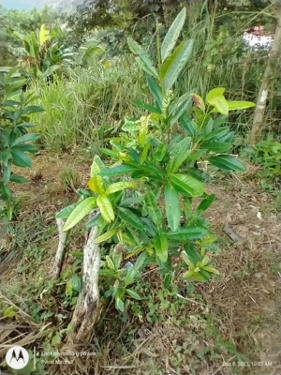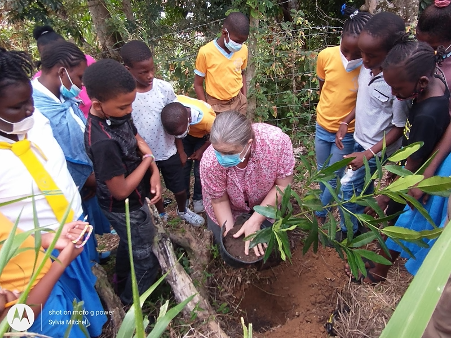Students planting yam
New Mount Industry Primary School
God works in mysterious ways, His wonders to perform. Far up in the hills of St Catherine is the New Mount Industry Primary School. It is 448 m above sea level and can only be reached by going through many hills and valleys.
We first introduced you to New Mount Industry School in 2022 (in FCRain Vol 2 Issue 31), when we shared the planting of a bay (Pimenta racemosa) tree in the school garden. This school garden is a collaborative effort of the UWI Biotechnology Centre, the New Mount Industry Primary School, 4H Club, Optimist Club, JAS (Jamaica Agricultural Society), RADA (Rural Agricultural Development Authority), and the Rio Pedro Watershed Management Council.
BAY (PIMENTA RACEMOSA)


The ‘West Indian Bay Tree’ we planted is growing well.
YAMPIE (Dioscorea trifida) SEEDLINGS
New Mount Industry Primary School was one of five field test sites where we planted yampie seedlings in August 2023. On December 8, we returned and collected survival and growth data of these seedlings. This required moving gingerly between the bay and Otaheite apple trees, lemon grass, turmeric, and other plants down a quite steep slope.
I am glad to report that the seedlings are growing well and that I did not slip! Farmers were also trained how to collect this growth data.
1. 4H STUDENTS PLANTED YAM PLANTS AT MOUNT INDUSTRY
On December 8, we also transferred hardened yam plantlets to the soil. This story has several parts:
- The yam farmers in the area provided yam tubers between January and March 2023 to the Medicinal Plant Research Group, UWI, Mona.
- The yams were initiated into tissue culture (Stage 1), multiplied (Stage 2), and rooted (Stage 3) in the lab from March to October (I promise another article to describe this process step by step).
- In October, rooted yam tissue culture plantlets were transferred from the glass vessels in the lab into toilet rolls, filled with soil (hardening stage), while multiplication continues in vitro (in vitro means ‘under glass,’ so we are growing them in the lab in glass vessels).
- In December, the hardened yam plantlets were ready to be taken to the field.
- Finally, on December 8, we planted 22 of these plantlets into the soil, assisted by the 4H students and teachers of the New Mount Industry Primary School.
I wish you could have heard the young 4H clubbites eagerly and intelligently answering as
I asked them about the plant tissue culture process.


They eagerly collected their yam plantlet, each in a toilet roll filled with soil, and, guided by 4H teachers, they lined up to enter the garden in teams of three — one held the plantlet carefully, one carried water to settle the plantlet into the soil, and the other took a label with the name of the yam plant to identify it in the ground.
A farmer, Mr Creary, and I helped them with the planting.
In all, 22 hardened plantlets of St Vincent, Chinese, Sweet, Hard, Mozella, and Tau were planted. Over the coming months, the children and their 4H teachers will be watering, weeding, and staking these yam plantlets. The first generation of tubers will be ready in nine months. I invite you to look out for updates on how they are managing the growth of the yam as we track the plantlets’ progress from soil to dining table.
The future of our children is in the hands of God. Together, we can!
Oh, the depth of the riches both of the wisdom and knowledge of God! How unsearchable are his judgments and his ways past finding out! Romans 11: 33.
____________________________________
- Dr. Sylvia Adjoa Mitchell, Senior Lecturer, Medicinal Plant Research Group, Faculty of Science and Technology, UWI, Mona Campus, Jamaica; sylvia.mitchell@uwimona.edu.jm

